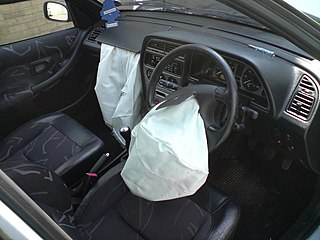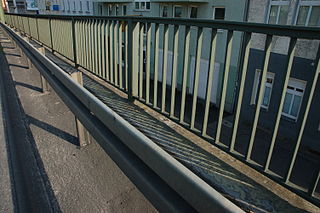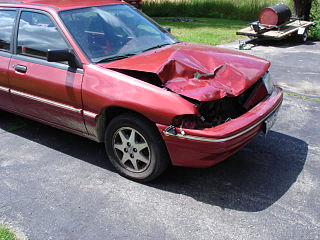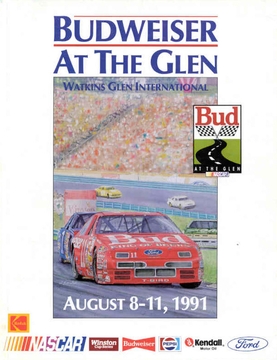
An airbag is a vehicle occupant-restraint system using a bag designed to inflate exceptionally quickly and then deflate during a collision. It consists of an airbag cushion, a flexible fabric bag, an inflation module, and an impact sensor. The purpose of the airbag is to provide a vehicle occupant with soft cushioning and restraint during a collision. It can reduce injuries between the flailing occupant and the vehicle's interior.

The National Hot Rod Association (NHRA) is a governing body which sets rules in drag racing and hosts events all over the United States and Canada. With over 40,000 drivers in its rosters, the NHRA claims to be the largest motorsport sanctioning body in the world.

Crumple zones, crush zones, or crash zones are a structural safety feature used in vehicles, mainly in automobiles, to increase the time over which a change in velocity occurs from the impact during a collision by a controlled deformation; in recent years, it is also incorporated into trains and railcars.

Road traffic safety refers to the methods and measures used to prevent road users from being killed or seriously injured. Typical road users include pedestrians, cyclists, motorists, vehicle passengers, and passengers of on-road public transport.

Dover Motor Speedway is a race track in Dover, Delaware. The track has hosted at least one NASCAR Cup Series race each year since 1969, including two per year from 1971 to 2020. In addition to NASCAR, the track also hosted USAC and the Indy Racing League. The track features one layout, a 1.03 mi (1.66 km) concrete oval, with 24° banking in the turns and 9° banking on the straights. The speedway is owned and operated by Speedway Motorsports.
The Texas A&M Transportation Institute (TTI) in Bryan/College Station, Texas is a transportation research agency in the United States. The institute was created in 1950, primarily in response to the needs of the Texas Highway Department. TTI is a state agency and a member of the Texas A&M University System.
John Cooper Fitch was an American racing driver and inventor. He was the first American to race automobiles successfully in Europe in the post-war era.

The Steel And Foam Energy Reduction Barrier, sometimes generically referred to as a soft wall, is a technology found on oval automobile race tracks and high speed sections of road and street tracks, intended to absorb and reduce kinetic energy during the impact of a high speed crash, and thus, lessen injuries sustained to drivers and spectators. It was designed by a team of engineers at the Midwest Roadside Safety Facility at the University of Nebraska-Lincoln. It was developed from 1998–2002, and first installed at the Indianapolis Motor Speedway in May 2002.

John Delphus McDuffie Jr. was an American racing driver. He competed in the NASCAR Winston Cup Series from 1963 to 1991, collecting 106 top-10 finishes during his career, despite never finishing on the lead lap of any race in his career, and holding the record for the most starts in NASCAR's top level without a win with 653. He died in a racing accident during the Budweiser at The Glen at Watkins Glen International in 1991.

Guard, Guard rails, guardrails, railings or protective guarding, in general, are a boundary feature and may be a means to prevent or deter access to dangerous or off-limits areas while allowing light and visibility in a greater way than a fence. Common shapes are flat, rounded edge, and tubular in horizontal railings, whereas tetraform spear-headed or ball-finialled are most common in vertical railings around homes. Park and garden railings commonly in metalworking feature swirls, leaves, plate metal areas and/or motifs particularly on and beside gates.
The Midwest Roadside Safety Facility is a research organization in Lincoln, Nebraska that conducts automotive crash testing. MwRSF is operated by the University of Nebraska–Lincoln (NU) and researches highway design and safety with a particular emphasis on safety performance evaluations of roadside appurtenances. Since its establishment in 1974, the facility has evaluated existing barriers and frequently developed new design concepts and technologies for use on public roadways.

An impact attenuator, also known as a crash cushion, crash attenuator, or cowboy cushion, is a device intended to reduce the damage to structures, vehicles, and motorists resulting from a motor vehicle collision. Impact attenuators are designed to absorb the colliding vehicle's kinetic energy. They may also be designed to redirect the vehicle away from the hazard or away from roadway machinery and workers. Impact attenuators are usually placed in front of fixed structures near highways, such as gore points, crash barrier introductions, or overpass supports. Temporary versions may be used for road construction projects.

Traffic barriers keep vehicles within their roadway and prevent them from colliding with dangerous obstacles such as boulders, sign supports, trees, bridge abutments, buildings, walls, and large storm drains, or from traversing steep (non-recoverable) slopes or entering deep water. They are also installed within medians of divided highways to prevent errant vehicles from entering the opposing carriageway of traffic and help to reduce head-on collisions. Some of these barriers, designed to be struck from either side, are called median barriers. Traffic barriers can also be used to protect vulnerable areas like school yards, pedestrian zones, and fuel tanks from errant vehicles.
Simpson Performance Products is an American motorsports parts supplier that manufactures safety products such as gloves, helmets, harness systems, driver's suits, head restraints, and shoes. It is marketed to racers ranging from participants at local track days to international Formula One and NASCAR teams. It was started by Bill Simpson as Simpson Drag Chutes.

A cable barrier, sometimes referred to as guard cable or wire rope safety barrier (WRSB), is a type of roadside or median safety traffic barrier/guard rail. It consists of steel wire ropes mounted on weak posts. As is the case with any roadside barrier, its primary purpose is to prevent a vehicle from leaving the traveled way and striking a fixed object or terrain feature that is less forgiving than itself. Also similar to most roadside barriers, cable barriers function by capturing and/or redirecting the errant vehicle.

Road traffic collisions generally fall into one of five common types:

Safety in NASCAR has evolved into one of the biggest concerns in stock car racing's largest sanctioning body. Mainly after the death of Dale Earnhardt, a seven-time Winston Cup Series champion, NASCAR has decided to change all of their safety policies, such as the use of the HANS device. Since 2001, NASCAR has also changed the cars for the NASCAR Cup Series and the Xfinity Series. NASCAR's safety policy includes the racing fire suit, carbon fiber seating, and roof flaps.

The 1991 Budweiser at The Glen was the 18th stock car race of the 1991 NASCAR Winston Cup Series and the sixth iteration of the event. The race was held on Sunday, August 11, 1991, before an audience of 125,000 on the 2.428-mile (3.907 km) short course at Watkins Glen International in Watkins Glen, New York, USA.

Tyler George Reddick is an American professional stock car racing driver. He competes full-time in the NASCAR Cup Series, driving the No. 45 Toyota Camry XSE for 23XI Racing, and part-time in the No. 26 Toyota Supra for Sam Hunt Racing. He is a two-time champion in the NASCAR Xfinity Series, winning consecutive titles in 2018 and 2019. Reddick was the victor in the closest finish in NASCAR's top three series, edging out Elliott Sadler at Daytona International Speedway during the 2018 Xfinity Series season when he won by 0.0004 seconds.
The University of Nebraska–Lincoln College of Engineering is the engineering college at the University of Nebraska–Lincoln (NU) in Lincoln, Nebraska. NU has offered engineering classes since 1877 and the College of Engineering was formally established in 1909. Since 1970, it has also encompassed the engineering students and facilities at the University of Nebraska Omaha. Lance Perez has served as dean of the college since 2018.














